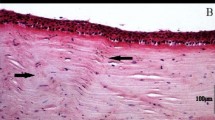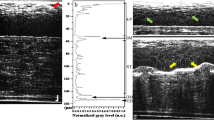Abstract
Purpose. To correlate the cross-sectional images of corneal diseases obtained by optical coherence tomography (OCT) with light microscopy (LM) to determine the corneal components represented in OCT images.
Methods. In a prospective comparative tissue study clinicopathological correlations of six patients with pseudophakic bullous keratopathy (n=3), advanced keratoconus (n=1), persistent epithelial defect with corneal thinning (n=1), and retrocorneal membrane (n=1) were included. Immediately before a planned penetrating keratoplasty (PKP) noncontact slitlamp-adapted OCT of the cornea was performed. After PKP and following standard histological processing the specimens were examined under LM to compare qualitatively the morphology, and quantitatively the morphometry at selected corneal locations.
Results. The cross-sectional optical-reflectivity profiles enabled the reproducible morphological evaluation of the corneal structures and changes. Layers of relative high reflectivity corresponded to the anterior corneal surface and internal stromal layers. In contrast, the deeper corneal epithelial layer demonstrated relative low reflectivity by OCT. An increase in light reflectivity corresponded to corneal scarring, irregularities of the corneal lamellae, and deposition of basal membrane material. Low signal intensity was particularly due to fluid accumulations and shadowing. The most prominent changes were caused by corneal scars or edematous tissue. The morphometric analysis with OCT revealed, in this study, thickness measurements ranging from 31 to 902 µm. Although the mean OCT thickness values were up to 9% (P=0.014) higher than those derived from LM, there was a significant positive correlation (r=0.94; P<0.001) between corneal OCT and the light-microscopic measurements.
Conclusion. Noncontact slitlamp-adapted corneal OCT revealed a good correlation with histological sections. The differences noted were partly related to shrinking processes during preparation. Thus, with certain limitations, OCT allows a non-invasive optical biopsy of pathological structures in corneal diseases.
Similar content being viewed by others
Author information
Authors and Affiliations
Additional information
Electronic Publication
Rights and permissions
About this article
Cite this article
Wirbelauer, C., Winkler, J., Bastian, G.O. et al. Histopathological correlation of corneal diseases with optical coherence tomography. Graefe’s Arch Clin Exp Ophthalmol 240, 727–734 (2002). https://doi.org/10.1007/s00417-002-0518-3
Received:
Revised:
Accepted:
Published:
Issue Date:
DOI: https://doi.org/10.1007/s00417-002-0518-3




